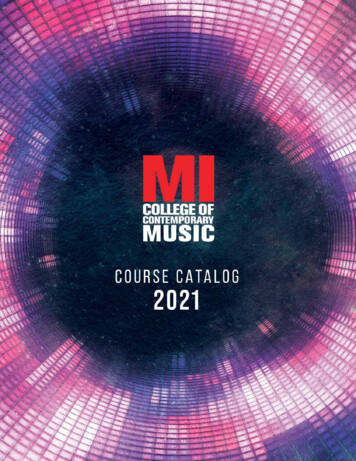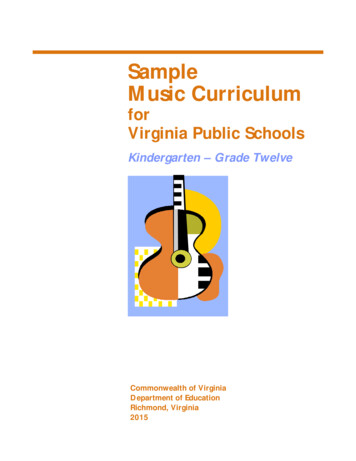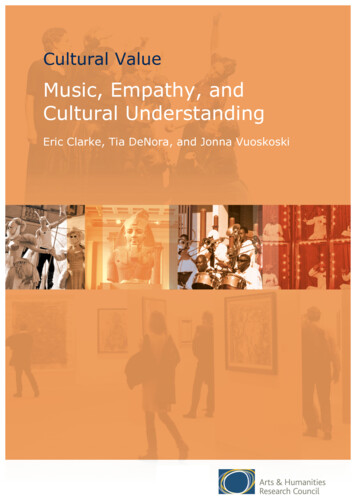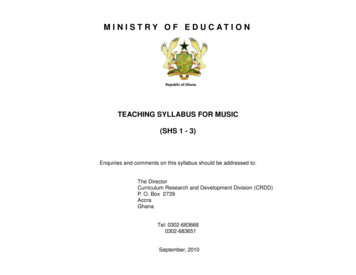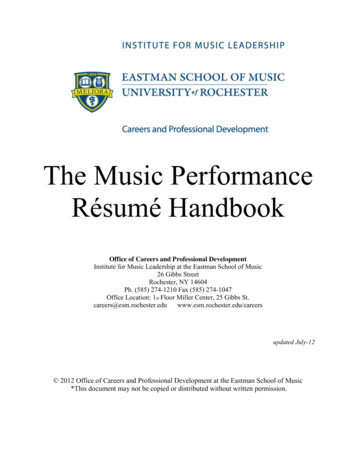
Transcription
The Music PerformanceRésumé HandbookOffice of Careers and Professional DevelopmentInstitute for Music Leadership at the Eastman School of Music26 Gibbs StreetRochester, NY 14604Ph. (585) 274-1210 Fax (585) 274-1047Office Location: 1st Floor Miller Center, 25 Gibbs careersupdated July-12 2012 Office of Careers and Professional Development at the Eastman School of Music*This document may not be copied or distributed without written permission.
Table of ContentsWhat is a Résumé?. 3The First Draft . 4Format . 6Style . 7The Finished Product . 9Sample Résumés.11Bibliography .19-2-
WHAT IS A RÉSUMÉ?A résumé is a formal overview of your past and current professional and educational experience. It should directly andconcisely list any experiences related to the teaching position you are seeking. Some description of your experiences maybe appropriate, but you should be as concise as possible. Remember, a résumé is not an autobiography – it is an outline ofyour experiences.Résumé or CV?Some people understandably confuse résumés and vitae. The two documents are very similar and many employers usethe terms interchangeably. In fact, employers in academia will often ask for a “vita” in an employment advertisementwhen they wish to receive a one to two page document that others might call a résumé.For practical purposes, this handout will focus on résumés used when seeking performance positions. This type of resumeshould be 1 page long.What is the difference between a résumé and a CV?The primary differences between a résumé and a vita (curriculum vita) concern issues of detail and content. Typicallyrésumés end at page one or two, CVs begin on page 3, but length is a secondary concern. A résumé is a summary of one‟sexperiences. A CV typically is an evolved résumé tailored to meet the rigors of a search for an academic position. Contenttypically includes earned degrees, evidence of research and/or scholarly work, teaching at the collegiate level,presentations and publications.Purpose and ImportanceAlthough a résumé is useful in a number of situations, it has two basic purposes. The first is to create in the reader suchan interest in you that s/he will want to invite you for an interview or audition. The résumé should serve essentially as anadvertisement of and for a product – you! It should make the employer (the “buyer”) want to take a closer look. Statisticsshow that the average employer spends less than 10 seconds scanning a résumé, so the overall design and format of arésumé is important!The other purpose of a résumé is to encourage potential employers to pay close attention to you when they do meet you orhear you perform. Remember, a résumé is your representative when you are not present. Thus, it must be perfect – wellorganized and highly polished. A great résumé alone will not get you a job, but a poor résumé can easily keep you fromgetting even an interview.-3-
THE FIRST DRAFT Résumé CategoriesThe following is a list of possible categories (in no particular order) that you may wish to include in your résumé.Look over these categories carefully and decide which ones would best present your professional and educationalexperience. Most importantly, do not feel compelled to follow a given formula, rather, design and organize your résuméso that it best highlights your experience.NameCompositions/ArrangementsSelected Compositions / PerformancesPremiersCurrent ProjectsCommissioned worksInstrument or Voice TypeContact InformationHome and/or Work addressCurrent/Permanent/After “x” datePhone numbersEmailRecordings and BroadcastsToursEducation/TrainingDegree(s) earned (include dates and institutions)Grade Point AverageHigh School Study (if at a major music institution)Major/Principal TeachersMaster ClassesCoachesSummer FestivalsProfessional Certification, Licensure, AccreditationCompetitionsPerformance ExperienceSolo ExperienceSolo with Orchestral EngagementsRecitalsChamber MusicOrchestras/Wind EnsemblesJazz/RockClubs, Jazz FestivalsFreelanceVoice-Opera, Roles Studied, Musical TheaterFull Roles, Partial RolesChoral ExperienceConducting / Guest Conducting PositionsOther ExperienceLanguage ProficiencyCommunity ServiceVolunteer WorkCollegiate Extracurricular ScholarshipsFellowshipsScholastic AwardsPrizes and Grants
Remember that this list is by no means all-inclusive!Some of the categories may not suit your purposes or needs and you probably won‟t have something that fits into everycategory. Don‟t worry!Many people make the common mistake of selling themselves short. They prejudge their past experience and itsinadequacies, often eliminating good, relevant experience before it ever has a chance to get down on paper. To be surethat you weigh your experiences evenly and avoid significant omissions, you should first get everything down on paper,and then decide what to keep and what to omit.In your first draft, write down everything under the appropriate category titles. Do not eliminate anything in the process.Save the editing of this information until you have a better sense of how you want to lay out your résumé. For now, justkeep an open mind!The following is an example of what a list might look like after a brainstorming session:Jane SmithViolin111 East Ave.Rochester, NY 14604(585) 555-1212Orchestra ExperienceRochester Philharmonic Orchestra, substitute, 2007Lancaster Festival Orchestra and Chamber Orchestra, 2007Eastman Philharmonia, concertmaster, 2006-07Aspen Chamber Orchestra, 2006-07Eastman Dryden Orchestra, concertmaster, 2006Eastman Graduate Chamber Orchestra, concertmaster, 2006-07Heidelberg Schloss Spiele Orchestra, 2005Eastman Opera Theater Orchestra, 2004-05Juilliard Pre-College Orchestra, assistant concertmaster, 1999-2000Solos with OrchestrasRidgewood Symphony Orchestra, Sandra Dackow conducting, 2007Juilliard Pre-College Orchestra, Ronald Braunstein conducting, 2000Livingston Symphony Orchestra, Istvan Jaray conducting, 2006Sewanee Festival Orchestra, Americo Marino and Patrick Strub, 2005Chamber musicCleveland Quartet Seminar, 2006-07Coaching with the Cleveland Quartet, John Graham and Catherine Tait.Performances in Kilbourn Hall and the Rochester Public Library.Juilliard Quartet Seminar, 2000Coaching with the Juilliard String Quartet.Performance in Paul Hall, Lincoln Center.Gainey Music Center, 1999Member of the Santiago Piano Trio.Eastman School of Music, 2003 – presentMusica Nova: contemporary ensemble. Performances for Charles Wuorinen,Michael Daugherty, others.Intermusica: chamber ensemble. Performances with Julius Baker, others.EducationMM, Performance and Literature, May 2007Eastman School of Music-5-
BM and Performer‟s Certificate, May 2005Eastman School of Music (valedictorian)Diploma, Juilliard School of Music, Pre-College Division, May 2000TeachersViolinWilliam PreucilDonald WeilersteinSylvia RosenbergSally ThomasChamber MusicKronos QuartetWilliam PreucilAbram LoftRobert SylvesterThomas PaulMaster ClassesJoseph GingoldCho-Liang LinJoseph BuswellJanet BookspanGilbert KalishFORMATOnce you have thoroughly brainstormed your past and current experiences, it is time to decide on a format for yourrésumé. The four most common résumé formats used by musicians are: Chronological Order of Importance Functional TargetedChronologicalA chronological résumé, as the name suggests, lists your work experience in chronological (or more typically, reversechronological) order. This format enables the reader to track your work history easily, check for gaps of unemploymentand visualize your professional growth.The entire résumé need not be in reverse chronological order. Most people who use this format will have sub-categories;much like those listed in the résumé category section on pages 5-6, and will arrange information in reverse chronologicalorder only within each category.Order of ImportanceWith this format, experiences are listed in the order of importance to the reader, enabling him/her to see your mostrelevant and impressive information first. This form is almost always used for performance résumés.FunctionalA functional résumé highlights your skills, abilities and accomplishments rather than the places where you obtained them.Past work experience should be listed separately, but the focus is on skills and identifying those that are transferrable tothe job to which you are applying. This format is not commonly used for music positions.TargetedA targeted résumé is not as much of a format as it is a style. It is often eclectic, using characteristics of each of the firstthree formats, and is used most often to produce a highly focused résumé for a very specific job. Most performancerésumés are targeted résumés; that is, they eliminate all peripheral information and discuss the only two things thatreaders/auditioners are interested in: training and performance experience.A targeted résumé does not have to be limited to performance jobs. Any résumé that you are writing solely for a specificjob would be a targeted résumé.-6-
OrderThe order of your résumé categories should reflect the position you are applying for and your level of experience. For aperson with years of performance experience, that is the first category an employer would want to read. However, for aperformer who has just graduated and does not have much experience, education is the first category an employer wouldwant to read. As you gain experience, you will rearrange your categories and add new listings and delete the older ones.STYLELetterheadThe top of your résumé should include your name, address, and contact information, including telephone number andemail address. Try to create a “letterhead” that will help your résumé stand out from others. You don‟t need anything tooflashy, but the use of something that is pleasing to the eye and reflects your overall style can also be used on your othersubmitted materials to give a professional, uniformed look.Some examples of letterheads:Jane Smith, violin111 East Avenue, #C11 Rochester NY 14604(585) 555-1212 jd000e@mail.rochester.eduJANE SMITH, violin111 east avenue, #c11rochester, ny 14604cell (585) 555-1212jd000e@mail.rochester.edu Jane Smith violin111 East Avenue, #C11Rochester NY 14604(585) 555-1212jd000e@mail.rochester.eduJane Smith,violin111 East Avenue, #C11Rochester, NY 14604(585) 555-1212jd000e@mail.rochester.edu111 East Avenue, #C11, Rochester, NY 14604Jane Smithviolin(585) 555-1212 -- jd000e@mail.rochester.edu-7-
What a final résumé might look like Jane Smith, violin111 East Avenue, #C11 Rochester NY 14604(585) 555-1212 jd000e@mail.rochester.eduORCHESTRAL EXPERIENCERochester Philharmonic Orchestra, substituteLancaster Festival Orchestra and Chamber OrchestraEastman Philharmonia, concertmasterAspen Chamber OrchestraEastman Dryden Orchestra, concertmasterEastman Graduate Chamber Orchestra, concertmasterHeidelberg Schloss Spiele OrchestraEastman Opera Theater OrchestraJuilliard Pre-College Orchestra, assistant concertmasterRochester, NYLancaster, OHRochester, NYAspen, CORochester, NYRochester, NYHeidelberg, GermanyRochester, NYNew York, NYSOLO PERFORMANCES WITH ORCHESTRARidgewood Symphony Orchestra, Sandra Dackow conductingJuilliard Pre-College Orchestra, Ronald Braunstein conductingLivingston Symphony Orchestra, Istvan Jaray conductingSewanee Festival Orchestra, Americo Marino and Patrick Strub conductingCHAMBER MUSIC EXPERIENCEEastman School of MusicMusica Nova: contemporary ensemble. Performances for Charles Wuorinen,Michael Daugherty, others.Intermusica: chamber ensemble. Performances with Julius Baker, others.Cleveland Quartet SeminarCoaching with the Cleveland Quartet, John Graham and Catherine Tait.Performances in Kilbourn Hall and the Rochester Public Library.Juilliard Quartet SeminarCoaching with the Juilliard String Quartet.Performance in Paul Hall, Lincoln Center.Gainey Music CenterMember of the Santiago Piano Trio.EDUCATIONMaster of Music, Performance and Literature,Eastman School of MusicBachelor of Music and Performer‟s Certificate,Eastman School of Music (valedictorian)Diploma, Juilliard School of Music, Pre-College DivisionMAJOR TEACHERSViolinWilliam PreucilDonald WeilersteinSylvia RosenbergSally ThomasChamber MusicKronos QuartetWilliam PreucilAbram LoftRobert SylvesterThomas 51999-00Ridgewood, NJNew York, NYLivingston, NJSewanee, TN2007200020062005Rochester, NY2003 – presentRochester, NY2006-07New York, NY2000Owatonna, MN1999Rochester, NYMay 2007Rochester, NYMay 2005New York, NYMay 2000Master ClassesJoseph GingoldCho-Liang LinJoseph BuswellJanet BookspanGilbert Kalish
THE FINISHED PRODUCTCreating an effective résumé requires time and careful revision. Once you have completed your résumé, take some timeaway from it to achieve distance. Then come back to it with a critical eye to see if it conveys a good candidate for thekind of position you want. Ask your teachers and colleagues to read your résumé and give you their impressions.Different opinions on the finished product can help you shape it further. However, remember, like musical tastes, therecan be a range of opinions on what produces the most successful document. Don‟t be afraid to make it your own withyour own unique style.Overall LookMake sure that the fonts you use are easy to read. You don‟t want to make your reader squint to read too-small print. Youalso want to avoid too-large print, which looks elementary and seems to be striving to fill space. Similarly, choose a fontstyle that looks professional. Don‟t play around with creative fonts as they distract and often annoy readers. Some goodexamples of font styles are Arial, Times New Roman, and Verdana.Whatever font style and size you choose, remember to be consistent. Don‟t switch from one to the other throughout yourrésumé, even to distinguish between category headings and entries. Instead, use bold, CAPS, or underlining to highlightimportant categories or subcategories. If you do decide to change font size as a means of distinguishing, make sure thedifference is subtle and doesn‟t call attention to itself rather than the content.The overall goal for readers is to find information easily. They should be able to quickly skip down the page to anycategory.PaperYou should invest in high-quality bond paper – it need not be too expensive, but should be better than regular photocopypaper. Choose an attractive color, one that is easy on the eye (e.g. off-white, ivory, pale grey). We strongly caution youagainst choosing a “wild” color (chartreuse, hot pink, etc.) as a way to “stand out.” Using such colors will attract noticebut will also scream “look at me!” as if the content might not be enough to grab a reader‟s attention. Think carefullybefore making such a choice. (Note: going with white bond paper may actually be one way of standing out since mostrésumés today are printed on light, non-white shades.)Emailing your résuméMany employers now accept résumés and cover letters electronically by email or by uploading it to their website. Whenemailing or uploading your résumé to a potential employer, send the document as a PDF. When emailing Worddocuments, the different versions of Word can change your formatting, font size and style to something other than whatyou intended. Be cautious of this and use PDF‟s whenever possible.InterfolioSome employers looking to hire performers require that transcripts and letters of recommendation be submitted along witha résumé and cover letter. An easy way to send all of these documents together in the same packet is to useInterfolio.com. The Office of Careers and Professional Development has partnered with Interfolio to offer an onlinecredential file service. This service allows file holders control over their files 24/7. Once you have created an account,you can upload your own résumés and cover letters. Consider opening a credential file with Interfolio.com before yougraduate from Eastman. It can also be opened as an alumnus; however, if you open the file while you are enrolled, youwill be eligible for a free account. Contact the Office of Careers and Professional Development for more information.Your credential file generally consists of your letters of references and unofficial transcript (must be initially requestedfrom the Office of the Registrar). You can also add to your file your CV and cover letter. This would allow you to be ableto send one package to the position you are applying for. Additionally, if you have certification documents, copies ofthese can also be uploaded as part of your file.Some job applications will require a credential file in the initial stages of a job application. If you are applying for manyjobs, as a courtesy to your referents, you should set up an Interfolio credential file. It saves your referents the trouble ofhaving to write the same letter for each of your job applications. Once you know that a letter from your referent hasactually arrived in your file, you can be confident that it will be sent out to arrive in a timely manner. Until a letter has-9-
arrived in your placement file, do not assume that a letter has been written or sent, despite assurances that it has! Mostletter writers have the best intentions, but are often swamped with a variety of duties, including writing letters ofrecommendation for people other than you. You can check to see if a letter has been uploaded by logging into yourInterfolio account. Make sure they have enough time to write a good letter on your behalf.Letters of RecommendationChoose referents you are confident will write stellar letters for you, and who will take the time to „go to bat‟ for you. Thereferents should know your work well, and should not necessarily be „big names‟. When asking these people for letters ofreference, ask them if they would feel comfortable writing a good letter of reference on your behalf. Depending on theirresponse, you can choose whether or not to have that letter sent out. By choosing your referents carefully, you retain alarge degree of control over the quality of your credential file.Confidential letters are highly recommended. They generally carry much more weight in a committee‟s mind. If youchoose to have confidential references placed in your file, the only thing that you can be told about your file is whether ornot the letter has arrived. Confidential references allow your writers to speak openly and candidly about your skills. Sochoose carefully!!!References that date back more than five years are not considered current, but can still be used. However, you should bearin mind that old references do not represent your current level of work and achievement.THE FINAL STEPSet up a meeting with the Office of Careers and Professional Development!We are here to help you with all your job search needs! Call, email or stop in to set up an appointment today. We‟rehappy to review your document and provide feedback on your finished product.- 10 -
SAMPLE RÉSUMÉS- 11 -
James BrowningBaritone240 South GoodmanLe Nozze de FigaroIl Barbiere di SivigliaAlbert HerringRed, Hot & Cole!Street SceneCandide (scenes)La BohèmeDido and ÆneasThe Rape of LucretiaThe MikadoTrial by JuryDon GiovanniCosì fan tutteLe Nozze di FigaroAriadne auf NaxosRochester, New York 14607RolesBartolo (in-house co.)Figaro (touring co.)BartoloInspector BuddMonty WooleyHenry DavisDr. PanglossBenoit/AlcindoroÆneasJuniusThe MikadoThe UsherDon Giovanni, Masetto*Guglielmo, Don Alfonso *Il Conte Almaviva *Harlekin, Musiklehrer*Bach Cantata 182Bach Matthaus-PassionHandel MessiahMozart RequiemMozart Coronation MassFauré Requiem 585/555-2710Eastman Opera TheaterEastman Opera TheaterEastman Opera TheaterEastman Opera TheaterEastman Opera TheaterEastman Opera TheaterOpera Theater of RochesterYale UniversityYale UniversityYale UniversityYale University*roles studiedSolo Concert WorkRochester Bach Festival; Melvin Butler, cond.Eastman Philharmonia; Donald Neuen, cond.Yale Glee Club; Fenno Heath, cond.Berkeley Chamber Players; Alexander Platt, cond.Yale Chamber Players, Dante Anzolini, cond.Yale Summer Chorus & Orch; Marian Dolan, cond.Eastman Chamber Ensemble; Judy Congdon, cond.Awards & Master ClassesWinner, Trumbull College Fine Arts CompetitionEastman School Voice FellowshipMaster classes, Janet Bookspan (Dramatic interpretation)Master classes, Seth McCoy, tenorMaster classes, William Sharp, baritoneMaster class, Carol Webber, sopranoMaster class, Barbara Hill Moore, sopranoVoice teachers:Voice coaches:Seth McCoy, tenorKenneth MerrillKorby Myrick, mezzo Yehudi WynerBarbara Kilduff, sopranoTrainingDrama teachers:Lynn SingerJames SimpsonChristina CurrenDavid DeRose (directing)EducationB.A. Theater/English Yale University, New Haven, CTM.M. Vocal PerformanceEastman School of Music, Rochester, NY, in progress- 12 -
Henry Clay FordBass - BaritoneHome: 3244 Winton Road South #H22Rochester, New York 14623(585) 555-2338 home/msg.West Coast: 134044 Avenida GrandeSan Diego, California 92129(619) 555-1223 (parents)Union Affiliations: A.G.M.A., A.F.T.R.AOpera Theatre ExperienceLa BohèmeBenoit/Assistant DirectorEastman School/Opera Theatre of RochesterBoris GodunovFeatured Dancer, “Polish Act”San Diego Opera/Russian Arts FestivalBallad of Baby DoeHorace Tabor (u.s.)/JacobDorian Opera TheatreMy Fair LadyCockney Quartet/Butler; Servant‟s Chorus Opera PacificLa BohèmeCustoms House GuardSan Diego Opera“Uniformly good singing from the Mimi. . . to the crusty Customs House Guard” – San Diego MagazineBarbiere di SivigliaFiorello (u.s.)San Diego OperaDie FledermausFrankSanta Barbara Civic Light OperaI Quattro RusteghiCancianPacific Chamber OperaThe MikadoPooh-BahSan Diego Gilbert & Sullivan Co.“Easily the member of the cast with the greatest comic flair was Henry Clay Ford as Pooh-Bah.” – San Diego UnionMusical Theatre ExperienceFiddler on the RoofTevye (u.s.)/NachumEvitaGeneral, AristocratStudent PrinceDr. Engel (u.s.)/ArnheimBabes in ToylandFatherAnnieDrakeBrigadoonAndrew McLarenSan Diego Civic Light Opera (Starlight)StarlightStarlightStarlightStarlight – Best Supporting ActorStarlightRecording, TelevisionPro Arte Records CDD 480, “H.M.S. Gilbert & Sullivan”Rochester Philharmonic Orchestra, Mark Elder, Conductor, with members of the Eastman Chorale“ . . . the first 11 ever, on a scale of 10 for Elder’s G&S.”Delos Records 3072, “Christmas with the Roger Wagner Chorale,” Roger Wagner, Conductor“ . . . sets a new standard in recorded vocal sounds.” – LA.TimesP.B.S. Television, San Diego Opera‟s Production of Lehar‟s “The Merry Widow” with Beverly And in These Times”HandelMozartDavid Ward-SteinmanSt. Peter‟s Episcopal, Del MarMozartImperial Valley Symphony Assn.,CentroCultural de Baja CaliforniaPalomar ChoraleInternational Orchestra, Zoltan Rosenyai, conductorHerod, Angel (world premiere)Apprentice Programs, Classes, AwardsPerformerOnandaga College“. . . a vastly talented singer. . .” – Mr. ReidApprentice ArtistOpera PacificApprentice AuditorSan Diego Opera CenterPerformerSan Diego Opera CenterAuditorWigmore Hall, London4th PlaceMetropolitan Opera AuditionsCornelius Reid Master ClassDr. David di Chiera, DirectorTito Capobianco, DirectorRegina Resnick Master ClassElizabeth Schwarzkopf Master ClassSan Diego RegionEducation/Special SkillsMaster of Music: Performance and Literature, Eastman School of Music, 1991B.F.A. Music: United States International University, 1988Vocal Training: Thomas Paul, Jane Randolph, Jonathan MackVocal Coaching: George Trovillo, Nico Castel, Janet Bookspan, Alexander RomPiano – 3 years; Viola – 5 years; Classical Guitar – 1 year; Organ – 1 year- 13 -
JDy KDSHOOPHLVWHU123 East Ave Rochester, NY 14607(508) 123-4567 jkmusic5@email.comEDUCATIONUniversity of Rochester, Eastman School of MusicMaster of Music, Organ Performance and LiteratureSeptember 2010University of Massachusetts AmherstMaster of Music, Choral ConductingBachelor of Music Education, cum laudeSeptember 2006May 2001CHURCH EXPERIENCEInterim Music Director, Bethany Presbyterian Church, Rochester, NY2009-present Direct Bethany Choir (adult choir) and Singers in the Spirit (teen choir) Oversee Children’s and Bell Choir directors; substitute for Bell Choir director as needed Manage all aspects of choirs, including budget, rehearsals, planning, and library management Play organ and piano for hymns, anthems, and other music for two weekly services plusweddings, funerals, and special services Organize and lead two Music Sunday services per year, including hiring, rehearsing, andconducting an orchestra Attend weekly staff meetings and coordinate all musical activities at the churchOrganist, Webster Presbyterian Church, Webster, NY Prepared and performed hymns, preludes, postludes, and other service music Accompanied chancel choir on weekly anthems Led choir rehearsals in absence of choir director2008-2009Music Director, St. Mark’s Episcopal Church, East Longmeadow, MA Directed adult choir and coordinated all musical repertoire at the church Prepared and performed appropriate preludes, postludes, and other organ music Conducted choir and instrumentalists for 1-2 major works per year2005-2008Organist, Notre Dame du Bon Conseil Church, Easthampton, MA Performed preludes, postludes, and hymns for one weekly mass Accompanied adult choir2005-2006Music Director, The Newman Center Catholic Church, Amherst, MA Conducted adult and college choirs Coordinated all repertoire/musical activities for three weekly masses, weddings,funerals, and special services Established a contemporary music ensemble for the Sunday evening college mass1998-2001Pianist, First Parish Unitarian Universalist Church, Northboro, MA Played service music and accompanied adult choir1995-1997CHORAL CONDUCTING/TEACHING EXPERIENCEChoral Music Teacher, Eaglebrook School, Deerfield, MA2006-2008 Conducted the Eaglebrook Chorus and the a cappella group Ad Libs Selected repertoire for chorus; arranged and transcribed songs for Ad Libs Developed and taught the music curriculum for a mandatory Introduction to the Arts class Taught Music History, Music Theory, Percussion Improvisation, Musical Theater Workshops,Piano, and Eastern Philosophy- 14 -
Jay Kapellmeister, p. 2(CHORAL CONDUCTING/TEACHING EXPERIENCE Continued)Graduate Student Conductor, University of Massachusetts Amherst2004-2006 Rehearsed and conducted Women’s Choir and University Chorale for two semesters each Selected repertoire Performed administrative duties Served as assistant conductor and tenor section leader of the UMass Chamber ChoirChoral Music Teacher, Quabbin Regional High/Middle School, Barre, MA2001-2004 Selected repertoire for and conducted the 7th grade Girl’s Chorus, 8th grade Mixed Chorus, HighSchool Women’s Choir, Select Women’s Choir, Concert Chorus, and Singers (select ensemble) Organized, updated, and expanded music library and equipment Established and taught after-school piano classes for elementary school studentsACCOMPANYING EXPERIENCEPiano & Organ Accompanist, University of Rochester Eastman School of Music Accompany the Repertory Singers on piano and organ for rehearsals and performances Accompanied the Eastman Chorale on organ for two performances in 20092008-2010Piano & Organ Accompanist, Smith College, Northampton, MA Rehearsed and performed with the College Chorus on piano and organ Directed rehearsals in the conductor’s absence2006-2007Piano Accompanist, University of Massachusetts Amherst Accompanied the University Chorale for rehearsals and performances1999-2000Additional Accompanying Experience Organist (continuo), Voices, Rochester, NY Rehearsal Pianist, Commonwealth Opera, Florence, MA Pianist, Amherst Congregational Church Pianist, Assabet Valley Mastersingers, Northboro, MA Rehearsal Pianist, Valley Light Opera, Amherst, MA Piano Accompanist, Quabbin Valley Festival Women’s Choir, Palmer, MA Keyboardist, King Richard’s Faire, Carver, MA Keyboardist, Tavé Hu Rock Band Pianist, St. Rose of Lima Summer Bible Camp, Bolton, MA Pianist, Ashby Big Band, Ashby, MA Pianist, UMass jazz combo, Amherst, MA Substitute: at the following Trinity Church, Northboro, MA; First CongregationalChurch, Spencer, MA; Holy Trinity Church, Hatfield, MA; First CongregationalChurch, Greenfield, MA; Second Congregational Church, Greenfield, MA; EdwardsChurch, Northampton, MA; St. John Cantius Church, Northampton, MA; Helen HillsHills Chapel, Northampton, MA; First Congregational Church, Marlboro, MA; St. AnneRC Church, Rochester, NY; St. Mark’s & St. John’s Episcopal Church, Rochester, 20041997-20001997-200119971999-2005CHORAL PERFORMANCE EXPERIENCEEnsembleSchola CantorumSouth Hadley ChoraleHodieAll Saints Episcopal Church ChoirSt. Paul’s Cathedral ChoirEdwards Church, tenor section leaderConductorStephen KennedyDeanna JosephDeanna J
The primary differences between a résumé and a vita (curriculum vita) concern issues of detail and content. Typically résumés end at page one or two, CVs begin on page 3, but length is a secondary concern. A résumé is a summary of one‟s



